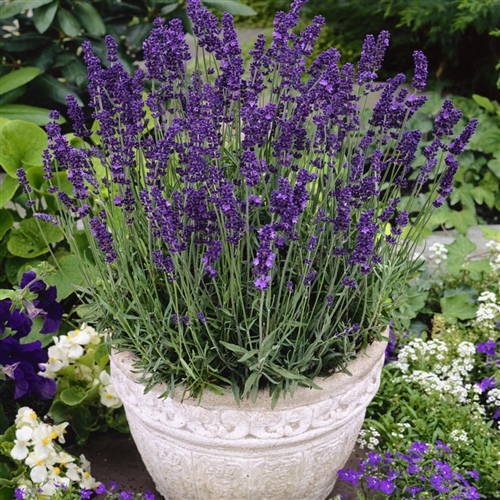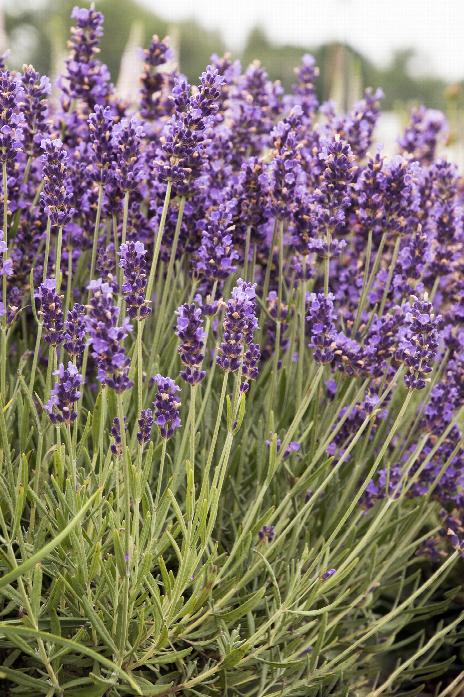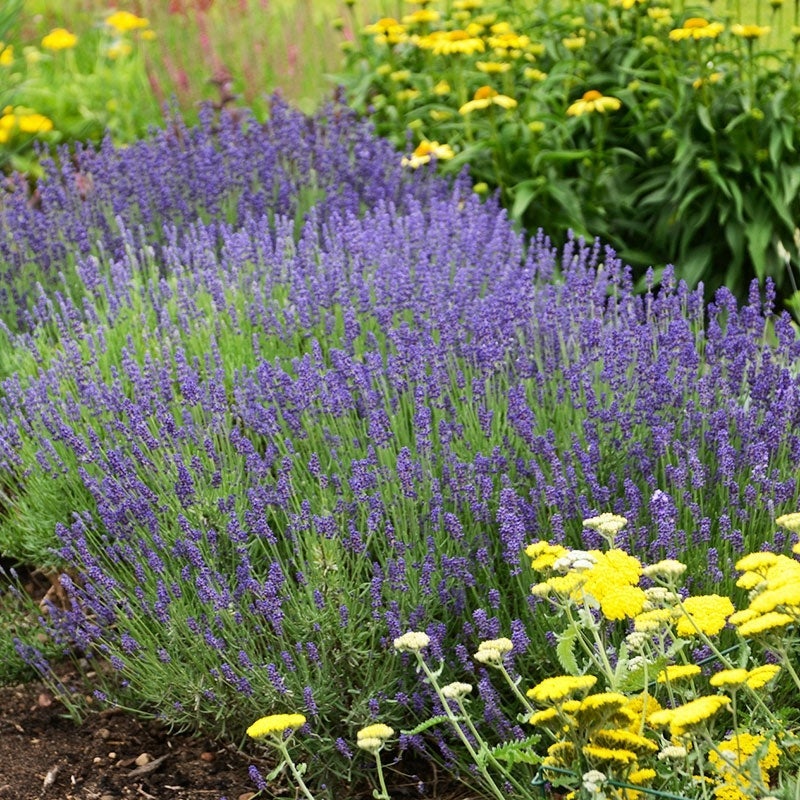
English lavender known as Lavender Hidcote (Lavandula angustifolia) is prized for its resilience, potent scent, and capacity to withstand harsh winters. Due to its low maintenance requirements and frequent use as an ornamental hedge, hidcote is favored by both professional growers and amateur gardeners.
Here is a quick glance at the lavender hidcote’s growing requirements and maintenance recommendations.
| Conditions | Requirements for Lavender Hidcote |
| Size: | 20 to 24 inches (50-60 cm) in width and 15 to 20 inches (40 to 50 cm) in height. |
| Flowering Time: | flowers that blossom in May or June and continue for three to four weeks. |
| a lifetime | 15 years with ideal circumstances and care. |
| Sun: | whole sun (will not tolerate shade). |
| Watering: | After planting, water frequently. Once established, water once every two weeks from spring to fall. Do not water in the winter. |
| Favorable soil types | Sandy, well-draining soils with low to moderate fertility. |
| pH of soil | accepts slight acidity but prefers neutral or alkaline soil (up to pH 8). (pH 6.5). |
| Date of Planting: | Although it will survive summer planting, early spring or fall are the best times for planting. Hidcote shouldn’t be planted or moved during the winter. |
| Pruning: | Trim the top flexible growth by about two-thirds in the early spring or late fall. Pruning annually helps Hidcote lavender live longer by extending its life. Avoid cutting into the woody root because it does not recover. |
| Planting separation: | When planting in garden borders, keep plants 3 feet away from one another and 2 feet apart when hedging. |
| Hardiness: | tolerates winters that can reach a low of -15°C (5°F) and frost. USDA zones 5, 6, 7, 8, and 9. |
| Winter Care | In cool, temperate areas, sandy soil with good drainage is very important to prevent fungal illness. In winter, avoid watering. |
| Fertilizer: | Hidcote doesn’t require fertilizer and is low maintenance. |
| Problems: | Due to excessive irrigation, poorly draining soils, or humid regions, fungi like root rot are frequently seen in plants.Deer and rabbits are not attracted to the greenery. |
Continue reading to learn where to plant Hidcote, how to care for it, how to prune it, what kind of soil to use, and other tips for a robust bloom and a healthy lavender plant.
Table of Contents
Where to Plant
Hidcote lavenders are a hardy cultivar of English lavender that can grow in hot locations like California or Southern Europe and can withstand cold winters with frost and snow.
Hidcote can thrive in relatively high rainfall, cool temperate areas, and full sun, or at least six hours of sunlight each day.
The more sun the stronger the aroma from the foliage and the more blossoms on exhibit.
Lavenders are native to Europe’s coastal locations, where they enjoy moderate breezes and good ventilation between the foliage, which lowers the chance of fungus illness.
Hidcote does not thrive in humid environments and is more likely to contract a fungus or pass away under these circumstances.
One of the few varieties of lavender that may survive in regions with harsh winters is the English variety (French lavenders are not cold hardy). Hidcote can withstand wintertime cold temperatures and has a 15-year lifespan.
(Learn more about the distinctions between French and English lavender.)
Lavender does not tolerate moist soil around the roots, thus adequate soil drainage and soil that does not retain moisture are priorities in climates with cold Winters or high rainfall.
Learn how to modify the soil so that it is suited for lavenders by reading on.
Flowering
The flowers of the Lavender Hidcote persist for about 4 weeks and bloom in the spring or early summer, typically in May or June.
You can do a number of things to ensure a wonderful bloom show, including annual pruning in the early spring, deadheading the flowers as needed, and making sure the lavender is planted in the best soil with ample sunshine and sparingly watered.
Hidcote, like many other English lavenders, doesn’t flower for as long as French lavenders do, but the flowers and foliage have a much stronger, sweeter perfume. Commercial lavender farmers value cultivars like Hidcote for their oil and smell because of this.
The ecosystem of your garden will benefit greatly from the blooms, which are among the most beloved by pollinators like bees.
When to Plant
Although planting in the summer can be done effectively, early spring or early fall are the best times.
Although the daily temperatures are not as high as they are in the summer, which lessens the chance of the lavender drying out, the soil is warm enough and retains enough moisture in the early fall for the lavender’s roots to form swiftly.
Lavenders grow best in dry environments, but because their roots have not yet fully developed, plants can be vulnerable to drought right after planting. (Read my post on how frequently lavender needs watering to learn how to water lavender after planting.)
Hidcote will also have done flowering in the Fall, ensuring that the lavender bloom is unaffected and that the plant has had time to adjust to its new soil conditions.
Since Hidcote is a hardy plant, it may also be planted in the Spring or Summer without any issues; however, if you plant before the plant blooms, the number of flowers may be impacted.
Read my article on successfully transplanting lavender for additional details.
How Far Apart to Plant and Hedging
The lavender hedge grows nicely as a decorative hedge, in garden borders, and in pots and containers.
Lavender Hidcote spacing should take into account two important factors:
- to allow air to circulate around the leaves. (This lowers the chance of developing a fungal condition)
- To place them far enough apart so that they don’t compete for water and nutrients or throw shade on one another, so limiting each plant’s growth (lavenders require full sun).
Hidcote should be planted at least 2-3 feet apart. Although 2 feet apart is the minimum distance required, you can plant lavenders closer if the area has good airflow and wind.
Lavenders naturally grow in windy coastal regions because they do not thrive in high humidity.
Hidcote will expand to a width of roughly 20 inches, or slightly over one and a half feet, given the correct conditions (sun, low-medium fertility soil, occasional watering).
So, if you want to plant Hidcote for decorative hedging, space the lavender plants 2 feet apart, and they will grow into a neat, uniform hedge within a year or two with no gaps (during the spring and summer).
The hedge will look stunning and each plant will have adequate space for its root system to expand without fighting with its neighbor for space at 2 feet.
Hidcote is a very beneficial type for growing hedges since it is:
- a strong, resilient plant that endures winters of extreme cold.
- It may be easily propagated to replace plants that are damaged or die, and it has a considerably longer lifespan than most lavenders.
Find a breezy spot in your yard or grow lavender in pots and containers if your area has higher humidity levels. Lavender benefits from good ventilation.
Because there is often less airflow along garden borders, planting in pots or containers can help prevent the fungal infections that are brought on by greater levels of humidity.
Watering Lavender Hidcote

The dry, arid region of Southern Europe is where lavender is naturally found, where it grows well on soils that drain easily and do not retain much water.
In order for Hidcote to flourish, gardeners should reproduce these circumstances.
- If there hasn’t been much rain, established lavender Hidcote plants only need to be watered once every two weeks during the growing season.
- Hidcote often receives enough water from rainfall in cool temperate areas, only occasionally needing to be watered during particularly hot and dry spells of weather.
- The most care must be taken with newly planted lavender. While the roots are settling into their new home, water frequently. After the first month, reduce watering to once (in desert areas) or twice (in cooler climates) each week. Water every three days throughout the first month.
- Amount of water? Always give lavender a good soak when you water it because this helps the roots develop and take hold in the soil, which can help the plant withstand droughts in the summer.
Remember that Lavender Hidcote is drought tolerant; therefore, overwatering lavender causes more issues for gardeners than underwatering does.
Lavender is susceptible to the fungal illness root rot, which makes it droop, if you water it too frequently. (Read my post, Why is my lavender drooping, for information on all the symptoms of an overwatered lavender plant as well as the remedy.)
The simplest way to prevent issues brought on by excessive irrigation is to modify the soil using horticultural sand to promote excellent drainage.
The likelihood of the lavender getting root rot due to excessive watering or heavy rainfall is substantially lower if the soil drains adequately and does not retain much water.
Soil Mix and Planting
Providing it is grown in the right conditions, lavender hidcote requires little maintenance. The qualities of the soil are one of the most crucial factors.
Hidcote must be grown in soil conditions similar to those liked by lavender in Southern European coastal locations in order to be successful.
There is a need for soil that is:
- Sandy and well-draining so that it does not retain moisture
- medium to low fertility
- Instead of being compacted, it is aerated and has a porous structure.
- Alkaline soils with a pH of 6.5 to 8 are regarded as excellent.
Hidcote can be planted directly in the ground if your yard has naturally sandy, loamy, or chalky soil rather than soil that needs to be amended.
However, slow-draining soils with a high clay content, compacted soils, or too acidic soil do not support the growth of any lavender species.
You should dig a hole that is much larger than the root ball to adjust the soil before planting Hidcote, in my opinion. Distribute the soil in other parts of the garden, and then backfill the planting area with a mixture of about two thirds compost and one third sand or grit.
The majority of soils will benefit from the addition of sand because it will improve drainage greatly and balance the soil’s fertility, making it ideal for growing lavenders.
Any soil containing clay should be supplemented with grit, as the combination of sand and clay can result in a rigid structure resembling cement. Horticultural grit offers the ideal soil composition for rapid water drainage away from the roots.
Lavender should be planted in raised beds or containers where you have control over the soil profile if the soil is acidic or heavy clay because it can be very difficult and time-consuming to amend garden soil that doesn’t have the desired conditions.
Read my article on the best soil combination for growing lavenders to learn more.
Pruning
Lavenders should be pruned every year to prolong their life and promote new growth, which supports flower production.
Lavender will be better able to withstand the effects of weather, such as snow, ice, and wind, if it is pruned into a good, tidy, mound form (Hidcote is cold hardy and can tolerate Winters).
Without annual pruning, lavender plants become lanky, woody, and blossom much less.
the ideal time to prune?
Lavenders can be pruned either in the fall or at the beginning of spring (March/April).
English lavenders like hidcote should be pruned in the early spring as this will encourage new, robust growth for flowering.
Hidcote blooms in May or June, so if you prune the lavender in March or April, you’ll encourage a lot of new growth and the plant will be able to produce a lot of flowers.
English lavenders respond better to spring pruning than fall pruning, although French lavenders typically favor fall pruning because of their earlier flowering time.
What is pruning?
To shape the lavender into a spherical mound, trim off the top two thirds of the flexible growth (do not cut into the woody growth at the base).
Check out this YouTube video on pruning English lavenders for a step-by-step tutorial.
Winter Care
Hidcote requires little maintenance because it can withstand cold winters with snow, frost, and temperatures as low as -15°C (5°F) on occasion. However, there are several best practices to follow:
- The lavender plant may withstand weather by being pruned into a mound shape. Lavender’s woody base is very fragile, and plants that haven’t been clipped in a while tend to accumulate more snow, which will cause the lavender’s woody base to shatter.
- As lavender Hidcote favors dry environments, clear away any leaf litter and other organic debris that may have formed around the plant in the fall.
- Make sure the pot is at least 12 to 16 inches across if Hidcote will be planted in pots or other containers. This sized pot has the capacity to hold enough soil to further insulate the roots of your lavender from the cold weather.
- Winter is not the time to water the lavender because it is dormant and will get all the water it needs from its surroundings.
- In cold climates, well-draining soil is especially crucial for lavender because winter poses the greatest risk of disease. Approximately 30% sand should be added to the soil to improve drainage.
Avoid using Fertilizer
Hidcote prefers sandy soil that is low to medium in nutrients, as do all varieties of lavender. Fertilizer will encourage the growth of the leaves but with fewer flowers.
Due to too much nitrogen in the soil, the leaves may even turn yellow as a symptom of stress.
Lavender doesn’t need additional fertilizer or organic mulching in order to grow healthily and emit a potent perfume from poor soils.
Problems

However, root rot, a fungal disease, is the most frequent issue. As Hidcote favors dry conditions similar to those in the Mediterranean, root rot is typically brought on by overwatering, soils that drain too slowly, or places of excessive humidity.
With properly prepared soil, occasional watering, and lavender placed in a windy location, these issues are readily resolved.
Brown foliage and a drooping appearance are signs of root rot. If your lavender is going brown, see this post for solutions.
